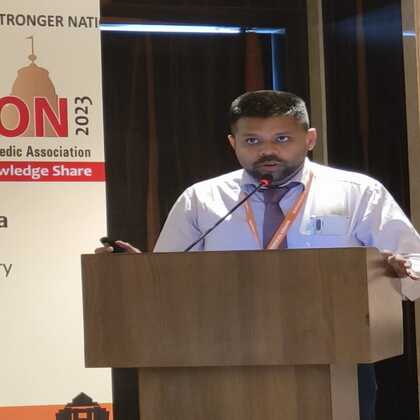Guide to Fragile Patient Broken Spine Regains Painless Movement Within 24
Learn how fragile patients can regain painless movement within 24 hours after a spinal fracture. Explore modern pain management, minimally invasive procedures, and rapid recovery strategies.

Written by Dr. Rohinipriyanka Pondugula
Reviewed by Dr. M L Ezhilarasan MBBS
Last updated on 29th Sep, 2025

Introduction
Witnessing a loved one, especially an elderly or fragile patient, suffer from a broken spine is a frightening experience. The immediate assumption is often a long, painful, and bed-ridden recovery. However, modern medicine has revolutionised the approach to spinal fractures. The goal is no longer just healing the bone; it's about restoring a painless, active life as quickly as possible. This guide is designed to demystify the process, offering hope and practical knowledge. We will explore how a tailored treatment plan can help even the most fragile individual regain comfortable movement, sometimes within the first 24 hours of intervention. We'll cover the causes, the latest medical advancements, and the crucial role of a support system in achieving a painless recovery journey.
Understanding a Broken Spine in a Fragile Patient
A broken spine, often referred to as a vertebral compression fracture, occurs when one of the bones in your spine (vertebrae) collapses. This is particularly common in individuals with osteoporosis, a condition that weakens bones, making them porous and fragile.
What Does "Fragile Patient" Mean in This Context?
In medical terms, a "fragile patient" typically refers to an elderly individual, often with osteoporosis, who may have other underlying health conditions like heart disease, diabetes, or general frailty. Their bone quality is compromised, meaning a simple action like bending over, coughing forcefully, or even a minor fall can be enough to cause a fracture. Their overall resilience is lower, which necessitates a more delicate and comprehensive approach to treatment.
Common Causes of Spinal Fractures in the Elderly and Frail
The most prevalent cause is osteoporosis. When bones are weak, everyday stresses can lead to a fracture. Other causes include:
- Low-Impact Falls: A slip from a standing height or even out of bed.
- Lifting a Heavy Object: A sudden strain on weakened vertebrae.
- Underlying Conditions: Certain cancers that metastasize to the bone can also cause pathological fractures.
Understanding the cause is the first step in crafting a treatment plan that not only addresses the fracture but also the underlying fragility to prevent future injuries.
Consult an Specialist for the best advice
The Goal: Why "Painless" Movement is Non-Negotiable
For a fragile patient, pain is not just a symptom; it's a significant barrier to recovery. Achieving painless movement is a critical medical objective.
The Vicious Cycle of Pain and Immobility
When movement causes sharp, debilitating pain, the natural response is to avoid moving altogether. This immobility leads to muscle weakness, loss of bone density, and joint stiffness. The weaker the muscles surrounding the spine become, the less support the fracture has, which can ironically lead to more pain. This creates a dangerous downward spiral that can result in pneumonia, blood clots, and a rapid decline in overall health.
Beyond Comfort: How Pain Management Aids Healing
Effective pain control breaks this cycle. By managing pain aggressively, patients feel empowered to participate in physical therapy sooner. Moving, even in a very limited way initially, improves blood flow, reduces the risk of complications from bed rest, and stimulates the body's natural healing processes. Therefore, a painless approach is directly linked to a faster and more successful recovery.
Modern Medical Approaches for a Painless Recovery
Gone are the days when the only option was extended bed rest and strong painkillers. Today, a multi-pronged strategy is employed to ensure comfort and rapid mobilisation.
Advanced Pain Management Protocols (Within 24 Hours)
Immediately after diagnosis, the focus is on controlling pain to allow for gentle movement. This involves a combination of:
- Targeted Medications: Instead of only general painkillers, doctors may use medications specifically designed for nerve pain or bone pain.
- Nerve Blocks: For severe pain, an interventional pain specialist can perform a nerve block, which can provide immediate and significant relief, creating a window of opportunity for early physical therapy.
Minimally Invasive Surgical Techniques: Kyphoplasty and Vertebroplasty
For appropriate candidates, these procedures are game-changers. They are designed to stabilise the fracture and relieve pain quickly.
How Kyphoplasty Can Restore Height and Reduce Pain Quickly
Kyphoplasty is a remarkable procedure. Under X-ray guidance, a small balloon is inserted into the fractured vertebra and gently inflated. This helps restore the vertebra's original height and creates a cavity. The balloon is then removed, and the cavity is filled with a special medical cement. This cement hardens quickly, stabilising the fracture from the inside. Many patients report a significant reduction in pain within a few hours to 24 hours after the procedure, allowing them to sit up and walk with much greater comfort.
The Role of Customised Orthotic Supports (Braces)
A well-fitted brace (or orthosis) provides external support to the spine, limiting painful motion at the fracture site. This allows the bone to heal while the patient can still move about. For a fragile patient, a lightweight, comfortable brace is essential to ensure compliance.
The 24-Hour Milestone: Regaining Movement Safely
The narrative of being confined to bed for weeks is outdated. The new standard of care emphasises mobilisation within the first day, when medically safe.
The Multi-Disciplinary Team: Your Partners in Recovery
A successful outcome relies on a team: your orthopaedic surgeon, a pain specialist, a physical therapist, and sometimes a geriatrician. This team works together to coordinate pain management, surgical intervention if needed, and immediate rehabilitation. If your loved one's condition does not improve with initial pain management, consulting a specialist team through a platform like Apollo24|7 can help you navigate these options efficiently.
First-Day Physical Therapy: Gentle, Guided Movements
Within the first 24 hours post-procedure or after pain is controlled, a physical therapist will assist the patient. This isn't about strenuous exercise. It involves:
- Learning safe ways to log-roll in and out of bed.
- Practicing sitting up on the edge of the bed without twisting the spine.
- Taking a few steps with a walker, under close supervision.
This early activity is crucial for building confidence and preventing the complications of prolonged immobility.
Long-Term Strategies for Sustained Painless Living
Recovery doesn't end at hospital discharge. Long-term management focuses on strengthening the body and preventing future fractures.
At-Home Exercises for Core Strength and Stability
A physical therapist will prescribe a gentle exercise regimen focusing on strengthening the core and back muscles. Strong muscles act as a natural brace for the spine. These exercises are typically low-impact, such as specific stretches or water-based therapy.
Nutritional Support for Bone Health
Addressing the underlying fragility is key. This includes:
- Calcium and Vitamin D: Essential for bone remodeling. A doctor might recommend supplements. Apollo24|7 offers convenient home collection for tests like vitamin D levels to check for deficiencies.
- Protein: Adequate protein intake is necessary for maintaining muscle mass, which supports the skeleton.
Fall Prevention: Making Your Environment Safe
Prevention is the best medicine. This involves making simple home modifications: removing loose rugs, installing grab bars in bathrooms, ensuring good lighting, and wearing sturdy, non-slip footwear.
Conclusion
The journey from a painful spinal fracture to painless movement is a testament to the advances in modern medical care. For the fragile patient and their caregivers, understanding that there are effective, rapid interventions available is the first step toward reclaiming mobility and independence. The focus has shifted from passive suffering to active recovery. By leveraging a combination of advanced pain management, minimally invasive procedures, and immediate rehabilitation, the goal of standing and walking without pain within a day is an achievable reality for many. If you or a loved one is facing this challenge, remember that you don't have to endure the pain. Seek a specialist evaluation to explore the options tailored to your specific needs and embark on the path to a painless, active life.
Consult an Specialist for the best advice
Consult an Specialist for the best advice
Dr. Anil Sharma
Orthopaedician
42 Years • MBBS, MS Orthopedics
New Delhi
AAKASH MEDSQUARE, New Delhi

Dr. Anil Pradeep Jadhav
Orthopaedician
23 Years • MBBS MS (Ortho)
Nashik
Apollo Hospitals Nashik, Nashik
(25+ Patients)

Dr. Manoj Dinkar
Orthopaedician
15 Years • MBBS, Dip (Orthopaedics)
New Delhi
THE DOCTORS NESST, New Delhi

Dr. Pradeep Lucas
Orthopaedician
7 Years • MBBS, Diploma in Orthopaedics, Fellowship in DFSI
Bengaluru
Revival Multispeciality Clinic, Bengaluru

Dr. Mriganka Ghosh
Orthopaedician
11 Years • MD (Physician), DNB (Orthopaedics)
Howrah
Dr Mriganka Mouli Ghosh, Howrah
Consult an Specialist for the best advice
Dr. Anil Sharma
Orthopaedician
42 Years • MBBS, MS Orthopedics
New Delhi
AAKASH MEDSQUARE, New Delhi

Dr. Anil Pradeep Jadhav
Orthopaedician
23 Years • MBBS MS (Ortho)
Nashik
Apollo Hospitals Nashik, Nashik
(25+ Patients)

Dr. Manoj Dinkar
Orthopaedician
15 Years • MBBS, Dip (Orthopaedics)
New Delhi
THE DOCTORS NESST, New Delhi

Dr. Pradeep Lucas
Orthopaedician
7 Years • MBBS, Diploma in Orthopaedics, Fellowship in DFSI
Bengaluru
Revival Multispeciality Clinic, Bengaluru

Dr. Mriganka Ghosh
Orthopaedician
11 Years • MD (Physician), DNB (Orthopaedics)
Howrah
Dr Mriganka Mouli Ghosh, Howrah
Frequently Asked Questions
1. What is the most common symptom of a spinal fracture in a fragile elderly person?
The most common symptom is a sudden onset of severe back pain, often described as a 'knifing' or 'stabbing' sensation. It's typically localised to one area of the spine and worsens with movement, standing, or walking. Sometimes, the pain can be mistaken for general arthritis, but its acute nature is a key differentiator.
2. Is surgery always necessary for a broken spine?
No, surgery is not always necessary. Many stable fractures can be managed conservatively with rest, bracing, and pain medication. However, for patients with severe, debilitating pain that doesn't respond to medication, or for unstable fractures, minimally invasive surgery like kyphoplasty is often recommended to provide rapid stability and pain relief.
3. How long does it take to recover from a kyphoplasty procedure?
The procedure itself takes about an hour per vertebra. Many patients experience significant pain relief within 24-48 hours. Hospital stay is typically short (often same-day or one night). Full recovery involves a period of limited activity and physical therapy, but most patients can return to their normal daily activities much faster than with non-surgical treatment.
4. Can a fragile patient with other health problems undergo these procedures?
Yes. One of the major benefits of minimally invasive techniques like kyphoplasty is that they are often well-tolerated even by patients who are not good candidates for major open surgery. The procedure is performed under local anaesthesia with sedation, which places less stress on the heart and lungs. A thorough pre-procedure evaluation by the medical team is essential to ensure safety.
5. What are the risks of not treating a spinal fracture aggressively?
The primary risk is the downward health spiral caused by prolonged pain and immobility. This can lead to muscle wasting, depression, pneumonia, deep vein thrombosis (blood clots), and a permanent loss of independence. Treating the fracture aggressively is as much about preventing these secondary complications as it is about healing the bone itself.